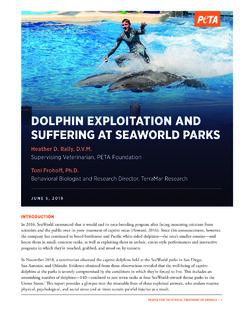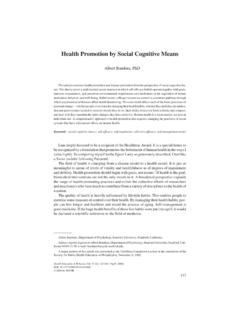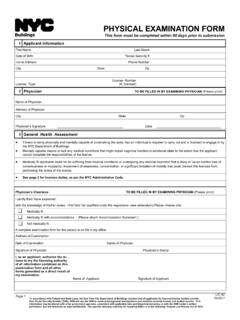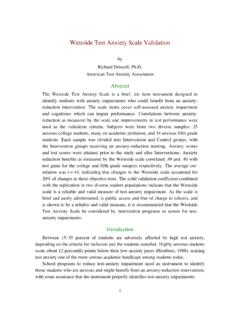Transcription of A Summary of the Effects of Captivity on Orcas
1 A Summary of the Effects of Captivity on OrcasPEOPLE FOR THE ETHICAL TREATMENT OF ANIMALSC ontentsThe Eff ects of Captivity on Tilikum and Orcas Generally at Orcas Are Extremely Intelligent Mammals Whose Brains Are Highly Developed in Areas Responsible for Complex cognitive Functions, Including Self-Awareness, Social Cognition, Culture, and Language ..4II. Tilikum Is Deprived of Every Facet of His Culture and the Opportunity to Engage in Natural Behavior, Causing Extreme Stress and Suff A. The Tanks at SeaWorld Provide Inadequate Space and Result in B.
2 SeaWorld s Constant Manipulation of Tilikum s Social Structure Results in C. The Tanks at SeaWorld Create a Distressing Acoustic The Stressors of the Captive Environment at SeaWorld Result in Aggressiveness, Self- Injury, and Other Physical and Behavioral A. Aggression Between Orcas and Between Orcas and B. Stereotypic 1. Painful Dental Problems Caused by Chewing Metal Gates and Concrete 2. Surface Resting and Lying on the Tank image: Terrell C. Newby, Effects of Captivity on Tilikum and Orcas Generally at SeaWorldOrcas are highly intelligent and social apex predators, and living in Captivity causes them extensive physical and psychological harm.
3 Among other things, the physical constraints of the artifi cial enclosures at SeaWorld limit their opportunity to exercise, disperse from incompatible pairings, escape from confl icts, or engage in natural types of behavior, such as swimming at high speeds or diving, causing them extreme stress and stress of the captive environment is manifested in physiological and behavioral abnormalities indicative of psychological distress and emotional disturbance, including stereotypic behavior, unresponsiveness, excessive submissiveness, self-infl icted physical trauma and mutilation, compromised immunology, and excessive At SeaWorld Orlando, Tilikum lies listlessly at the surface or the bottom of the tank for extended periods, displays aggression toward humans, bites on the gates and concrete sides of the tanks, and is charged at and raked by other Orcas so severely that he sometimes bleeds, shivers, and needs to be kept out of shows.
4 While Tilikum has reached the average life expectancy for a male orca, the same stressors impair captive Orcas immune systems so that they have a mortality rate two and a half times higher than wild Orcas , notwithstanding SeaWorld s alleged superior veterinary care and Summary of the Eff ects of Captivity on Orcas4A Summary of the Eff ects of Captivity on OrcasOrca brains share a number of important features with human brains that are associated with complex with the human brain, orca brains are much larger than expected for their body size.
5 The proportion of brain and body size is typically expressed as an encephalization quotient (EQ). The EQ for Orcas is , which means that even when their large body size is taken into account, their brains are still two and a half times larger than Orcas therefore have more brain tissue available to serve complex cognitive functions, such as self-awareness (a sense of personal identity), social cognition, culture, and In addition, the neocortex (the outer wrinkled surface of the cerebrum) of the orca brain is highly diff erentiated , diff erent parts have diff erent specialized functions and even surpasses the human brain in the degree of its convolutedness a measure of the surface area indicating the amount of information processing possible in the The neocortex is involved in integrating information from the diff erent senses to form mental representations of objects and thoughts and is also part of the cerebral cortex the system that processes higher-order thinking and complex, abstract processes.
6 Such as language, self-awareness, meta-cognition (the ability to think about one s own thoughts), social cognition, and theory of mind (the ability to think about and infer the thoughts of others).In addition to all these complexities, the orca brain also contains spindle-shaped cells known as von Economo neurons in the same areas of the brain as These spindle cells are found in the parts of the brain that are thought to be involved in high-level cognitive processing, such as social and emotional cognition, awareness, and This includes feelings of empathy, guilt, embarrassment, and pain, as well as judgement [sic], social knowledge, and consciousness of visceral feelings.
7 7 I. Orcas Are Extremely Intelligent Mammals Whose Brains AreHighly Developed in Areas Responsible for Complex cognitive Functions, Including Self-Awareness, Social Cognition, Culture, and Language5A Summary of the Eff ects of Captivity on OrcasFinally, orca brains possess a highly developed paralimbic region,8 which is believed to be involved in processing and integrating emotional information with other thought processes. In fact, the human brain is not elaborated in the same way and does not have an identifi able paralimbic lobe, which suggests that the orca brain may have evolved certain kinds of sophisticated or complex functions and thought processes related to the processing of emotion that did not evolve in the human brain or at least not to the same with their complex intelligence and cognitive abilities, Orcas are among the most highly social, far-ranging, communicative, and culturally complex mammals on the planet.
8 Orca populations are distinguishable by diet, morphology, dialect, social structure, genetics, and behavior. Their transmission of these group-specifi c vocal and physical types of behavior from generation to generation in complex multicultural societies is recognized as a form of culture that, to researchers knowledge, is unique outside causes Tilikum severe psychological and emotional suff ering by depriving him of, among other things, adequate space, environmental enrichment, social stability, and the opportunity to perform natural behavior such as swimming long distances, diving, and foraging.
9 The confi ned space, repeated scheduled performances, and related training completely compromise his autonomy. This deprivation is physically and psychologically harmful to Orcas , and, as discussed below, causes them to display indicators of stress and trauma, which, notably, includes aggression, self-injury, and increased tanks at SeaWorld off er woefully inadequate space for an orca. Orcas are one of the fastest animals in the sea, traveling at speeds of up to nearly 28 miles per II. Tilikum Is Deprived of Every Facet of His Culture and theOpportunity to Engage in Natural Behavior, Causing Extreme Stress and SufferingA.
10 The Tanks at SeaWorld Provide Inadequate Space and Result in StressThey are also adapted for swimming extended distances and durations. Individual Orcas have been recorded traveling nearly 100 miles per day10 and are capable of covering vast distances of many thousands of They regularly dive 200 to 300 meters (656 to 984 feet)12 and spend 95 percent of their time In the wild, Orcas swim almost According to a reference book for zoos, aquariums, and wildlife parks and a standard course textbook for zoo biology students, the design and construction of marine-mammal habitats should consider the natural history and behavior of the species to be maintained and should permit the performance of most, if not all, of their natural behaviors.







